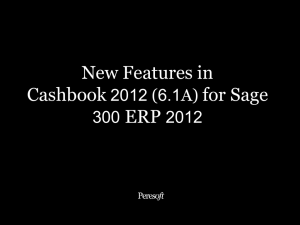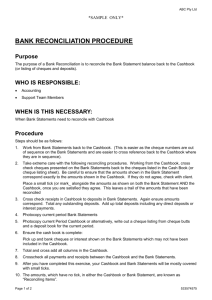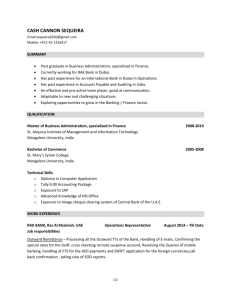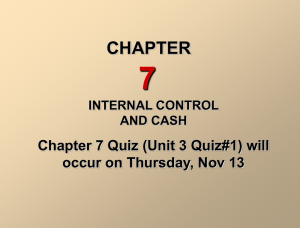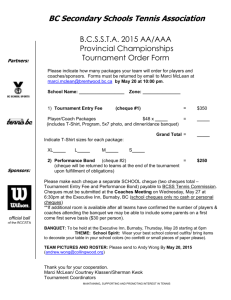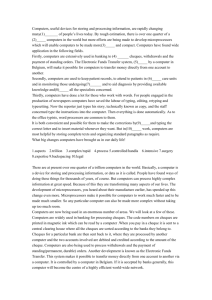Bank Reconciliation & Procedures
advertisement
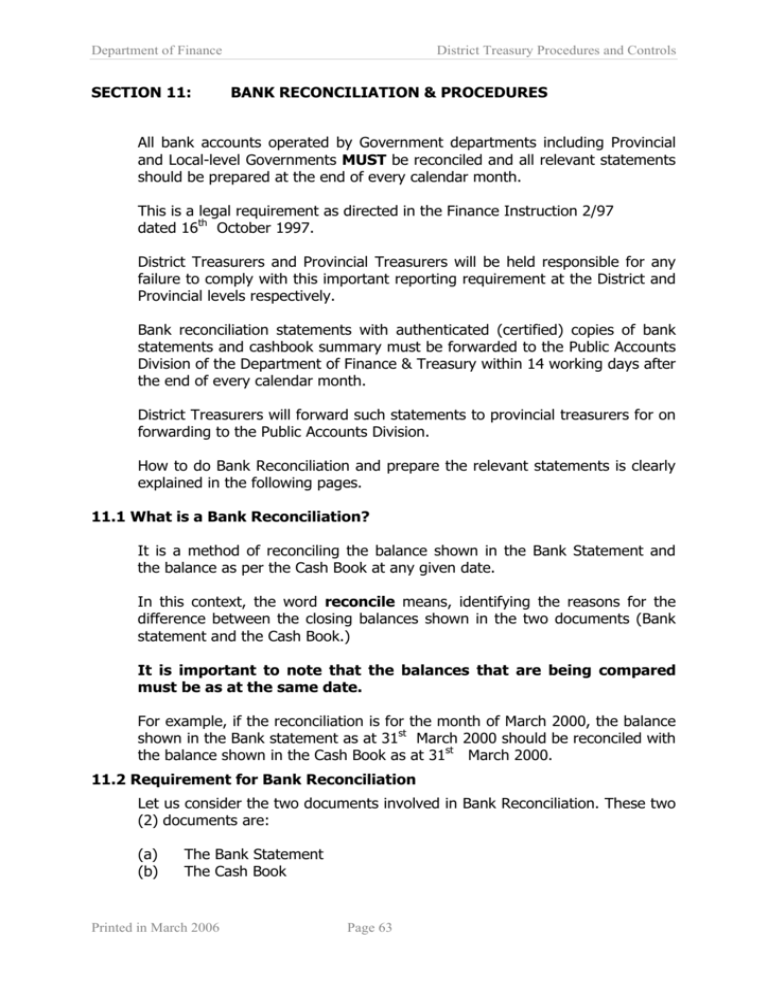
Department of Finance SECTION 11: District Treasury Procedures and Controls BANK RECONCILIATION & PROCEDURES All bank accounts operated by Government departments including Provincial and Local-level Governments MUST be reconciled and all relevant statements should be prepared at the end of every calendar month. This is a legal requirement as directed in the Finance Instruction 2/97 dated 16th October 1997. District Treasurers and Provincial Treasurers will be held responsible for any failure to comply with this important reporting requirement at the District and Provincial levels respectively. Bank reconciliation statements with authenticated (certified) copies of bank statements and cashbook summary must be forwarded to the Public Accounts Division of the Department of Finance & Treasury within 14 working days after the end of every calendar month. District Treasurers will forward such statements to provincial treasurers for on forwarding to the Public Accounts Division. How to do Bank Reconciliation and prepare the relevant statements is clearly explained in the following pages. 11.1 What is a Bank Reconciliation? It is a method of reconciling the balance shown in the Bank Statement and the balance as per the Cash Book at any given date. In this context, the word reconcile means, identifying the reasons for the difference between the closing balances shown in the two documents (Bank statement and the Cash Book.) It is important to note that the balances that are being compared must be as at the same date. For example, if the reconciliation is for the month of March 2000, the balance shown in the Bank statement as at 31st March 2000 should be reconciled with the balance shown in the Cash Book as at 31st March 2000. 11.2 Requirement for Bank Reconciliation Let us consider the two documents involved in Bank Reconciliation. These two (2) documents are: (a) (b) The Bank Statement The Cash Book Printed in March 2006 Page 63 Department of Finance District Treasury Procedures and Controls 11.3 The Bank Statement This is a record kept by the bank of all the transactions going through a bank account. In addition to the name of the account and the account number a bank statement will show the following. 1 2 3 4 An opening balance. A closing balance. Debits (Payments/Outgoings) Credits (Receipts) The opening balance (sometimes called the brought forward balance, B/F) is the balance at the beginning of the month, this balance should be exactly same as the closing balance shown in the statement for the previous month. The closing balance is the balance on the last day of the month. This will be the balance that will be reconciled with the closing balance shown in the Cash Book. For instance the opening balance for the month of March 2000 is the closing balance at the end of February 2000. The first thing to check before doing a bank reconciliation for the month of March 2000 is that the opening balance shown in the statement for March is exactly same as the closing balance shown in the statement for February 2000 (the previous month). Now let us consider the Debits (payments) and the Credits (receipts) shown in the bank statement. The figures shown in the debit column are all payments – money going out of the account. The figures shown under the credit column are all receipts – money coming into the account. A simple bank statement will appear as below. Printed in March 2006 Page 64 Department of Finance District Treasury Procedures and Controls Papua New Guinea BANKING CORPORATION Account Name :- XYZ LLG Office operating Account Number: - 00123456 Statement for the month of – March 2000 (Receipts) DEBIT K (Payments) CREDIT K DATES DETAILS 01.03.00 Balance B/F 03.03.00 Chq No. 0001 2,000 8,000 06.03.00 Chq No. 0002 1,000 7,000 09.03.00 Grants Recd 20.03.00 Bank fees 31.03.00 Balance Carried Forward 20,100 100 BALANCE K (Cr) 10,000 27,100 27,000 (Cr) 27,000 For Bank reconciliation purposes the balance to be compared with the cashbook balance as at 31.03.2000 is the closing balance of K 27,000(Cr) 11.4 The Cash Book This is the record kept in your office to enter all the transactions going through the Bank account. The cashbook also has a DEBIT column and a CREDIT column. All the money received (Receipts) are entered in the Debit column, and All the payments (Outgoings) are entered in the Credit column. NOTE :- Entries in the cashbook are done in the opposite way to what the Bank does, because a deposit by a Bank client is a liability or credit on the Bank. Payments (Outgoings) Receipts Printed in March 2006 Bank Statement Cashbook DEBIT CREDIT CREDIT DEBIT Page 65 Department of Finance District Treasury Procedures and Controls This happens because both the Bank and the account holder are following the double entry book keeping principles. In double entry book keeping an increase in assets (Cash in this case) is debited and a decrease in assets (Cash) is credited. The bank is recording from the opposite point of view and therefore the entries are in the opposite side from the cash book. To avoid any confusion caused by this, simply ignore the words debits and credits and treat them as receipts and payments. While reconciling simply compare the receipts shown in the bank statement with the receipts shown in the cashbook and the payments (Outgoings) shown in the bank statement with the payments shown in the cashbook without any concern for whether they are under the debit column or under the credit column. Now that we have looked at the two documents involved in the Bank Reconciliation let us go ahead and do the preliminary work required in Bank Reconciliation. The rest of the work that needs to be done is given below in 9 steps. Steps 1 to 8 cover the preliminary work required to do a successful reconciliation and Step 9 shows how to do the reconciliation. 11.5 Bank Reconciliation Steps Just follow the 9 steps carefully to successfully prepare a Bank Reconciliation Statement. Preliminary Steps STEP 1 a) Make sure that all the cheques drawn up to the last working day of the calendar month are entered in the cashbook. The best way to ensure this is to take all the cheque butts and tick them all one by one against the entries in the cashbook. If any of the cheques have not been entered in the cashbook , update the cashbook by entering those cheques showing the correct dates shown on the cheque butt and/or the supporting voucher. b) Make sure that all the receipts up to the last day of the month are entered in the cashbook. Printed in March 2006 Page 66 Department of Finance District Treasury Procedures and Controls This is done by checking all the bank deposit slips and the warrants/CFCs etc. received during the month against the entries under the receipt column in the cashbook. If any of those are not entered, update the cashbook again by entering those receipts showing the actual date of receipts. DO NOT CLOSE THE CASHBOOK AT THIS STAGE because when you go through the rest of the steps in Bank Reconciliation you may find more items that need to be entered in the cashbook before balancing and closing the Cashbook for the month. Keep the Cashbook open and go to Step 2. STEP 2 Check the opening balance in the bank statement for the current month with the closing balance shown in the statement for the previous month. These two figures must be exactly same to the last toea. This proves that the opening balance in the bank statement is correct. STEP 3 Keep the bank statement and the cashbook side by side and tick off all the matching entries. That is all the entries that appear in both the documents (Bank Statement and the Cashbook) are matched and ticked off. NOTE :- At this stage you may find some cheques appearing in the bank statement not appearing in the cashbook for the current month. These are cheques drawn in the previous months and will be shown on the list of unpresented cheques attached to the reconciliation done for the previous month. These cheques should be ticked off in the bank statement and in the list of unpresented cheques prepared for the previous month and not in the cashbook. If any more cheques remain unticked in the list of unpresented cheques for the previous month those cheques should be included in the list of unpresented cheques for the current month. STEP 4 Note down all the unticked items in the bank statement. These are unticked because they are not appearing in the cashbook. Examples of such items are, 1. Bank charges, fees, interest on loans etc debited by the Bank. The person writing up the cashbook will not be aware of these until the bank statement is received. 2. Direct deposits into the account and you are yet to receive the advice Printed in March 2006 Page 67 Department of Finance District Treasury Procedures and Controls from the party who deposited the funds into the account. STEP 5 Enter all the items noted in step 4 into the cashbook. Outgoings like charges and fees will be entered in the payment side of the cashbook and funds received will be entered in the receipt side of the cashbook. Now the cashbook is ready to be balanced and closed for the month. Balance the cashbook by adding all the receipts for the month to the opening balance and deducting all the payments/outgoings. The net balance is the closing balance that will be reconciled with the closing balance shown in the bank statement. Now you can prepare a Cashbook Summary and it will appear as below. XYZ LLG Operating Account Cashbook Summary for the month of March Balance Brought forward K 100 Add Total receipts during the month K 20,100 Less Total payments during the month K 6,200 Balance carried forward K14,000 STEP 6 Go through the cashbook and note down all the unticked entries in the cashbook. These are unticked because they are not appearing in the bank statement. These entries will be either, 1) Unpresented cheques. OR 2) Receipts entered in the cashbook but yet to be banked. Prepare a list of those unpresented cheques. Printed in March 2006 Page 68 Department of Finance District Treasury Procedures and Controls NOTE:- At this stage remember to include in the list, all the cheques still unticked in the list of unpresented cheques prepared at the end of the previous month. (refer to step 3) If there were any receipts in the cashbook not appearing in the bank statement prepare a list of these entries as well. (These are generally called “ bank deposits not credited”) Now you have two schedules, One is a list of cheques drawn but yet to be presented to the Bank by those parties to whom the cheques were given. (Schedule of unpresented cheques) And the other is a list of unrealised credits.( Schedule off deposits not credited) The schedule of unpresented cheques will be in the following format. List of unpresented cheques as at……………. Date (1) Cheque No. Payee’s Name Amount (2) (3) (4) In column (1) you will enter the date on which the cheque was drawn. In column (2) you will enter the cheque Number. In column (3) you will write the name of the person or the organisation to whom the cheque was made payable. In column (4) you will enter the amount for which the cheque was drawn. The list of deposits not credited will be in the following format. Deposits not credited as at ……………….. Date (1) Details (2) Amount (3) In column (2) you will enter the name of the person or organisation from whom the funds were received. STEP 7 There may be contra entries in the bank statement. This happens when the Bank makes corrections of wrong entries made by human error or when Printed in March 2006 Page 69 Department of Finance District Treasury Procedures and Controls cheques are dishonoured. Contra entry means, there will be an entry on the receipt side as well as on the payment side for exactly the same amount and the description in the details column will be something to the effect that it is a reversal or correction of a wrong entry with some sort of cross-reference. But if it is a dishonoured cheque the description will be "Dishonoured cheque number or unpaid item number." If it is a simple correction of error by the bank all you need to do is to put a mark “C” against the two entries instead of a tick. “C” means Contra. That is all you need to do and these entries will not affect your reconciliation exercise as long as you ignore all the entries against which you put the mark “C”. If it is a dishonoured cheque you will make a corresponding entry in the cashbook on the payments side (contra of a debit entry). If a cheque received from someone is dishonoured, you will make the entry on the payment side of the cashbook because initially when the cheque was received you would have entered it as a receipt. If a cheque drawn by your office is dishonoured for some reason, you will make the entry on the receipt side of the cashbook because when the cheque was drawn you would have entered it on the payments side. Once the entries are made tick them off in the bank statement and in the cashbook. STEP 8 Now you go through the bank statement and the cashbook once again and answer the following questions. 1) Is there either a tick or a (C) marked against every entry in the bank statement? 2) Are all the unticked entries in the cashbook included in one of the two schedules prepared in step 6 ? If the answers to the above 2 questions are “YES” that means you have correctly followed Steps 1 to 7 and the Bank Reconciliation Statement you are going to prepare in the next step will definitely balance provided that you have correctly added your Receipts and Payments in the Cash Book. STEP 9 -RECONCILIATION Now you have got all the figures necessary to do the Bank Reconciliation. Printed in March 2006 Page 70 Department of Finance District Treasury Procedures and Controls 11.6 Reconciliation Statement Doing the Bank reconciliation is simply filling the blanks in Part A of the MONTHLY FINANCIAL STATEMENT. In this statement the deposits not credited are called outstanding deposits. The figures shown in Schedule 1 prepared earlier should be entered in this section. The unpresented cheques shown in Schedule 2 will be entered in the column titled “Unpresented Cheques”. 11.7 Attachments to the Reconciliation Statement 1) Copy of Bank Statement 2) Cashbook Summary ( As shown in step 5 ) And finally forward the Bank Reconciliation Statement and a copy of the 2 attachments shown above to the Provincial Treasurer for on forwarding to the Public Accounts Division of the Department of Finance & Treasury. 11.8 Unpresented Cheques If a cheque is in the unpresented listing for two months follow up to see that the cheque has not been lost or stolen. It may be necessary to stop payment on the cheque and issue a new cheque. 11.9 Use of PGAS System for Bank Reconciliation Where the PGAS system is operational it is to be used to complete the Bank Reconciliation i.e. the matching of issued cheques with presented cheques, determination of the unpresented cheque list, the posting of fees and charges and processing of dishonoured cheques and stale cheques. The actual bank reconciliation needs be completed in the prescribed formats and sent monthly to Public Accounts Division: Assistant Secretary Accounting for review. Printed in March 2006 Page 71
